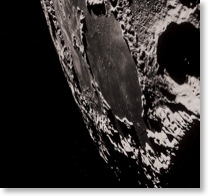Crater Creep
(This article has been reproduced from the Center for Scientific Creation. The original article can be found here.)A tall pile of tar will slowly flow downhill, ultimately spreading into a nearly horizontal sheet of tar. Most material, under pressure, “creeps” in this way, although rocks deform very, very slowly.
Calculations show that the growing upward bulges of large crater floors on the Moon should reach their current extent in only 10,000 to 10,000,000 years.[see footnote] Large, steep-walled craters exist even on Venus and Mercury, where gravity is greater, and temperatures are hot enough to melt lead. Therefore, creep rates on those planets should be even greater. Most large craters on the Moon, Venus, and Mercury are thought to have formed more than 4,000,000,000 years ago. Because these craters show no sign of “creep,” these bodies seem to be relatively young.
Footnote
Glenn R. Morton, Harold S. Slusher, and Richard E. Mandock, “The Age of Lunar Craters,” Creation Research Society Quarterly, Vol. 20, September 1983, pp. 105–108. The above study drew upon the work of Z. F. Danes, which was described as follows: The history of a circular crater in a highly viscous medium is derived from the hydrodynamic equations of motion by Z. F. Danes. The variation in shape of the crater in the course of time is expressed as a function of a time constant, T, that involves viscosity and density of the medium, acceleration of gravity, and radius of the crater lip. Correspondence between theoretical crater shapes and the observed ones is good. However the time constant, T, is surprisingly short if commonly accepted viscosity values are used. Geological Survey Professional Paper 550-A (Washington, D.C.: U.S. Government Printing Office, 1966), p. A 127.Since Danes’ work was published, rocks from the Moon have been returned to Earth and their viscosity has been measured. Their values fall in the range of 1021 to 1022 poises. According to the Geological Survey paper just quoted, “If viscosities of lunar rocks were around 1021 to 1022 poises, the ages of large craters would have to be only 104 to 107 years.”
----------
(This article was taken from the book, In the Beginning by Dr. Walt Brown. The book can be purchased from the Center for Scientific Creation. The original article can be found online here. For more information about Dr. Walt Brown, click here).
